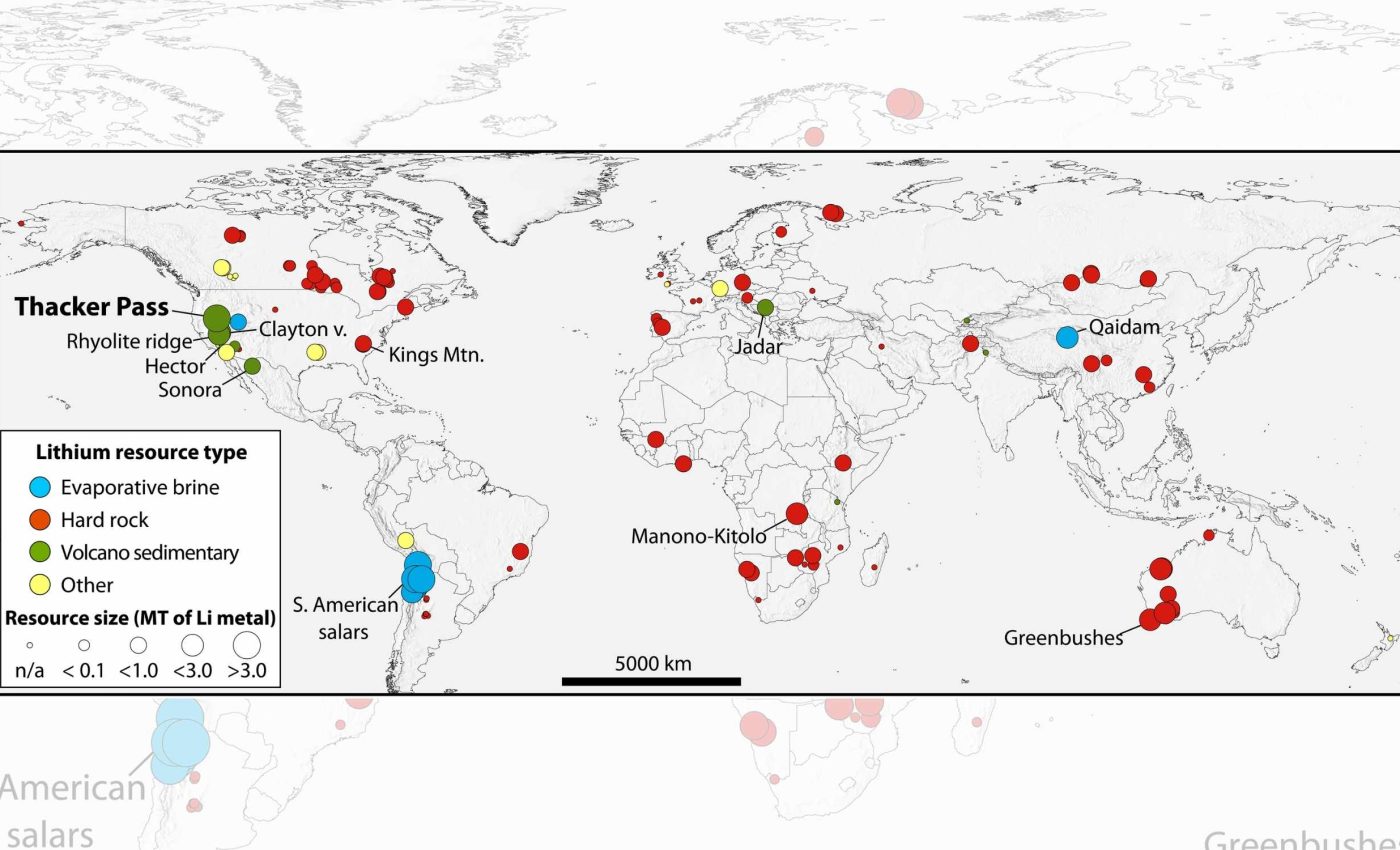
Ancient volcanic crater could turn the U.S. into the new global epicenter of clean energy
A peer reviewed study reports that parts of the McDermitt caldera hold unusually high amounts of lithium in its clays, concentrated at Thacker Pass in northern Nevada.
The most lithium-dense layer reaches grades high enough to matter at industrial scale, and the deposit sits near the surface.
The caldera spans about 28 miles by 22 miles on the Nevada-Oregon line. Geologists tie it to the Yellowstone hotspot, a long trail of ancient volcanic activity across the West.
Lithium in McDermitt caldera
A caldera, which is a large volcanic crater formed by collapse, traps sediments in a natural basin after a huge eruption. In this basin, volcanic ash weathered into clay and later concentrated lithium in a shallow, mineable zone.
The work was led by Thomas R. Benson, PhD, at Lithium Americas Corporation (LAC). His research focuses on lithium formation in volcanic terrains.
The key step was hydrothermal, hot water and dissolved minerals moving underground, circulation through the basin.
Those heated fluids flowed along faults, reacted with earlier clay, and carried lithium into a narrow, enriched horizon.
That horizon includes illite, potassium rich clay that can host lithium, which formed when the fluids altered earlier smectite clays. The highest lithium values sit in this illite dominated band along the basin’s southern rim.
What makes thacker pass different
The enriched layer is unusual because of its grade and thickness. Illite dominates for tens of feet, creating a clear contrast with surrounding smectite.
“They found lithium concentrations reaching about 1 percent by weight,” Benson explained. That’s roughly twice as rich as most other clay-based lithium deposits around the world.
Scientists also measured illite in the rock itself at about 1.3 to 2.4 weight percent lithium. Those are mineral scale results, but they help explain why whole rock samples tested so well across sections of the drill core.
The difference traces back to heat, fluids, and time. Hot fluids concentrated lithium, while the basin’s closed setting kept those elements from washing away.
Why tonnage and grade matter
For national supply, volume counts as much as grade. Independent estimates place the caldera’s in place lithium at tens of millions of tons, a range that signals a resource of rare scale.
Global production climbed in 2024 as battery demand stayed strong, and the United States still imports most of the lithium chemicals used by industry. A large domestic source could shorten supply chains and add price stability.
Grade and geometry affect land disturbance per ton produced. High grade, shallow claystone can reduce the amount of rock moved for the same output when compared with deeper or lower grade deposits.
Processing matters too, because clay hosted lithium is chemically bound. Companies must separate clay, leach lithium efficiently, and manage water carefully to meet both cost and environmental goals.
Testing the caldera for lithium
Geologists are refining the genesis model that links magma chemistry to later enrichment. The rocks are peralkaline, igneous composition unusually rich in sodium and potassium, which tends to retain lithium during magma evolution.
Field data suggest heat altered the basin from below. The team points to a period of resurgence, when magma pushed upward and reopened fractures, increasing fluid flow through the sedimentary pile.
The clay shift from smectite to illite records the temperature window of alteration. Illite forms at higher temperatures, so its presence maps the hottest paths of the ancient fluids.
Researchers also study lacustrine, formed in a lake environment, layers to learn how lake water chemistry sets the stage. Alkaline, closed basins can trap lithium and other elements that might otherwise flush away.
Clean energy shift in the U.S.
Federal decision documents approved construction for Thacker Pass in 2021 after a full environmental review. That approval marked a turning point from exploration toward phased development.
Local concerns remain, including water use, wildlife habitat, and cultural resources. Tribes and ranchers have pushed for rigorous safeguards, while the developer has outlined plans to limit impacts and monitor key indicators.
If the mine can deliver consistent output with low emissions per ton, it could support U.S. battery plants with a shorter logistics chain. That would complement recycling, which will take time to scale enough to cover a significant share of demand.
No single project can meet every need, but a large, shallow, high grade source changes the baseline. It reduces risk in the supply system while the country builds out refining capacity and recycling loops.
Examining the rocks
The deposit sits atop welded volcanic ignimbrite, solidified hot ash flow rock, which underlies the claystone. That firm base helped preserve the lake sediments during later uplift and erosion.
Lithium first accumulated in smectite across much of the basin. Later heating and fluid flow reorganized the elements into illite along a focused corridor.
Those temperature and fluid pathways left subtle textures in the cores. Veins, microfractures, and bitumen streaks mark episodes of circulation through the lakebed.
The result is a layered package that geologists can map and miners can model. Each layer reflects a different step in the path from eruption to ore.
Lithium, calderas, and energy
Other calderas lack the full recipe. Few combine the right magma, a sealed basin, long lived heat, and permeable layers that guide fluids.
The McDermitt system delivered a long cooling period. That sustained release of heat and fluids is crucial for moving lithium into a tight zone.
Regional tectonics also mattered. The basin sat still enough, long enough, to accumulate thick clay and then receive an extra pulse of heat.
A broad setting tied to the Yellowstone track provided the magma chemistry that favors lithium retention. That geologic backdrop helps explain why this crater stands out.
The study is published in Science Advances.
—–
Like what you read? Subscribe to our newsletter for engaging articles, exclusive content, and the latest updates.
Check us out on EarthSnap, a free app brought to you by Eric Ralls and Earth.com.
—–













